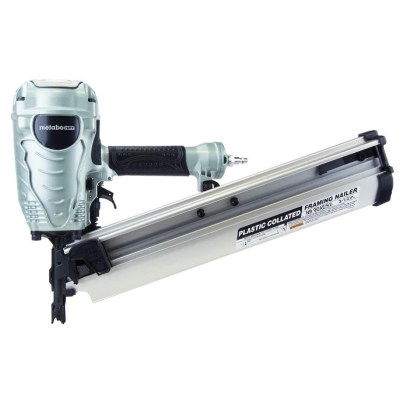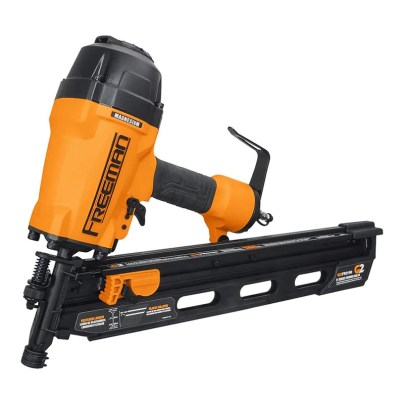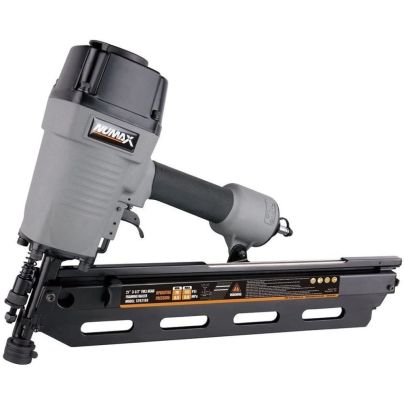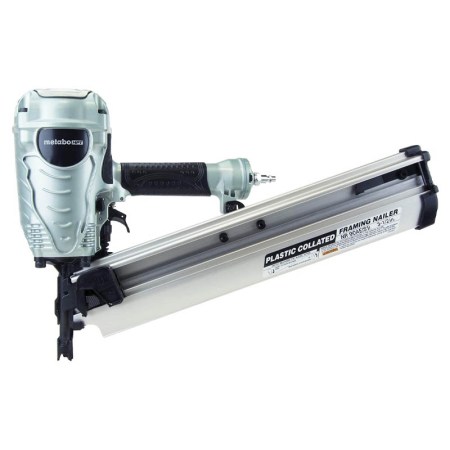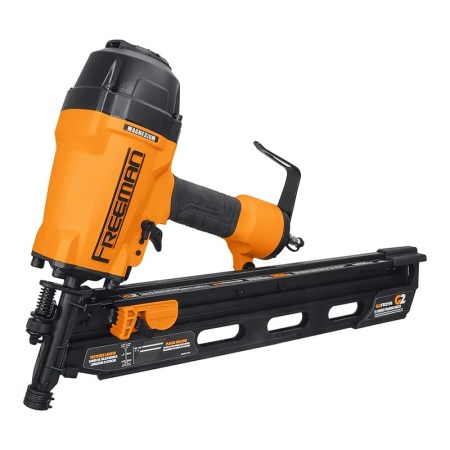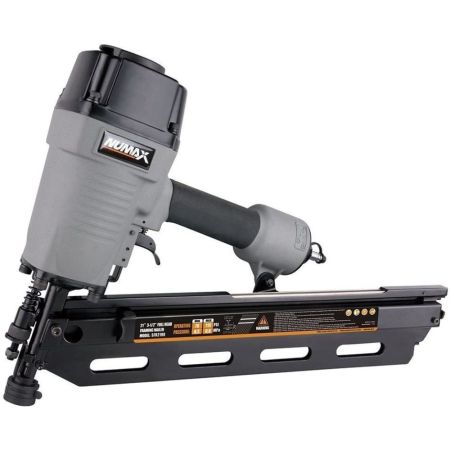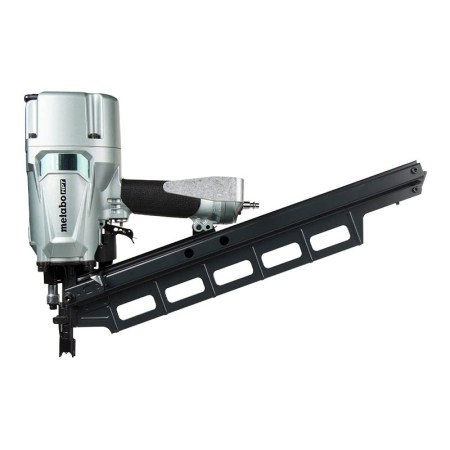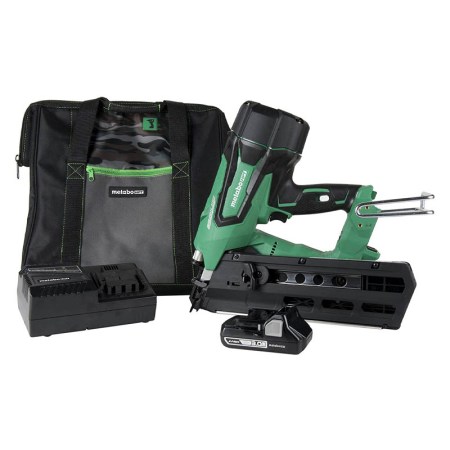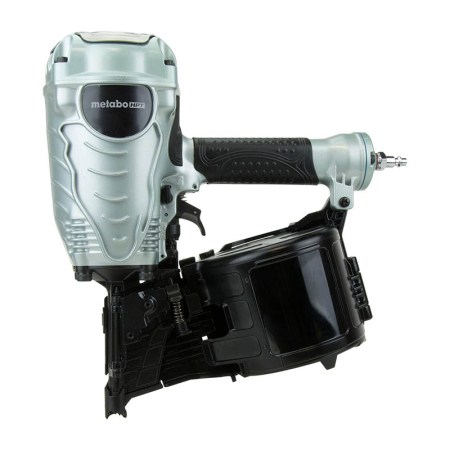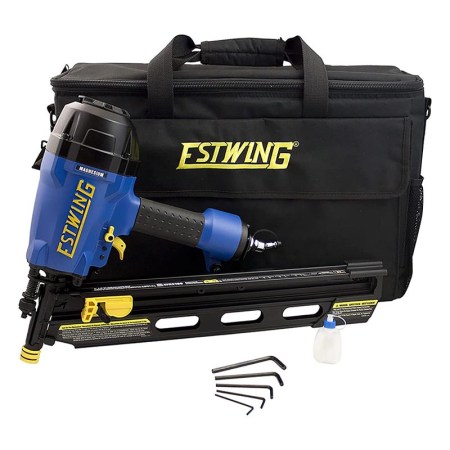We may earn revenue from the products available on this page and participate in affiliate programs. Learn More ›
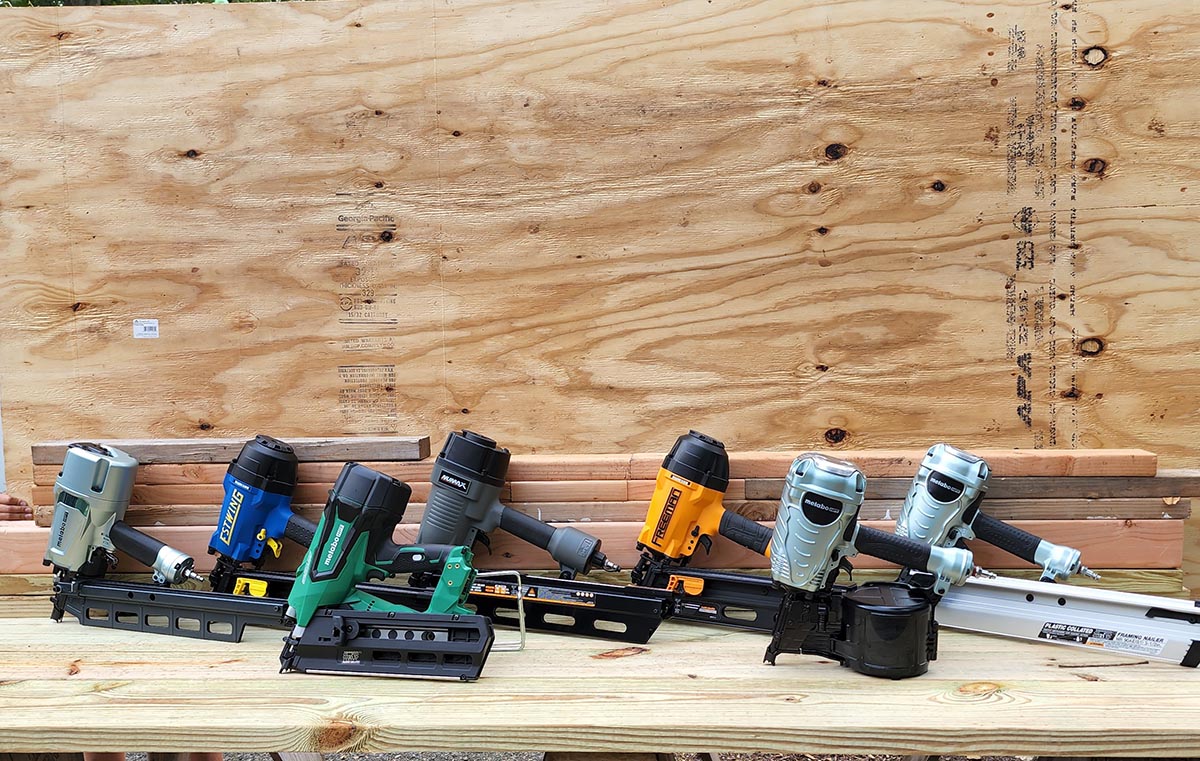
There was a time when neighbors could tell a crew was framing a house by the sound of metal-on-metal-on-wood, since hammering nails was the only way to connect large dimensional lumber. That sound is now a thing of the past, replaced by the repetitive “pop!” of framing nailers. These powerful tools operate by using combustion, electricity, or compressed air to create enough force to fire nails up to 3½ inches long into wood.
A huge boon to the construction industry and ambitious DIYers alike, framing nailers speed up what was once only possible through tedious manual labor. But just as the framing nailer is a specific type of nail gun, there are also different categories of framing nailers with varying features and functions geared to specific uses.
For anyone in the market for the best framing nailer, this guide will provide information to help make the right decision. It details what to look for when shopping for one of these tools and provides the results of our hands-on testing to show why the following are among the best framing nailer options available.
- BEST OVERALL: Metabo HPT NR90AES1 21-Degree Framing Nailer
- RUNNER-UP: Freeman G2FR2190 Pneumatic 21-Degree Framing Nailer
- BEST BANG FOR THE BUCK: NuMax SFR2190 Pneumatic 21-Degree Framing Nailer
- UPGRADE PICK: Metabo HPT NR83A5 21-Degree 3-1/4 Inch Framing Nailer
- BEST CORDLESS: Metabo HPT NR1890DRS Cordless Framing Nailer Kit
- BEST COIL-FRAMING NAILER: Metabo HPT NV90AGS Coil-Framing Nailer
- ALSO CONSIDER: Estwing EFR2190 21-Degree Full Head Framing Nailer
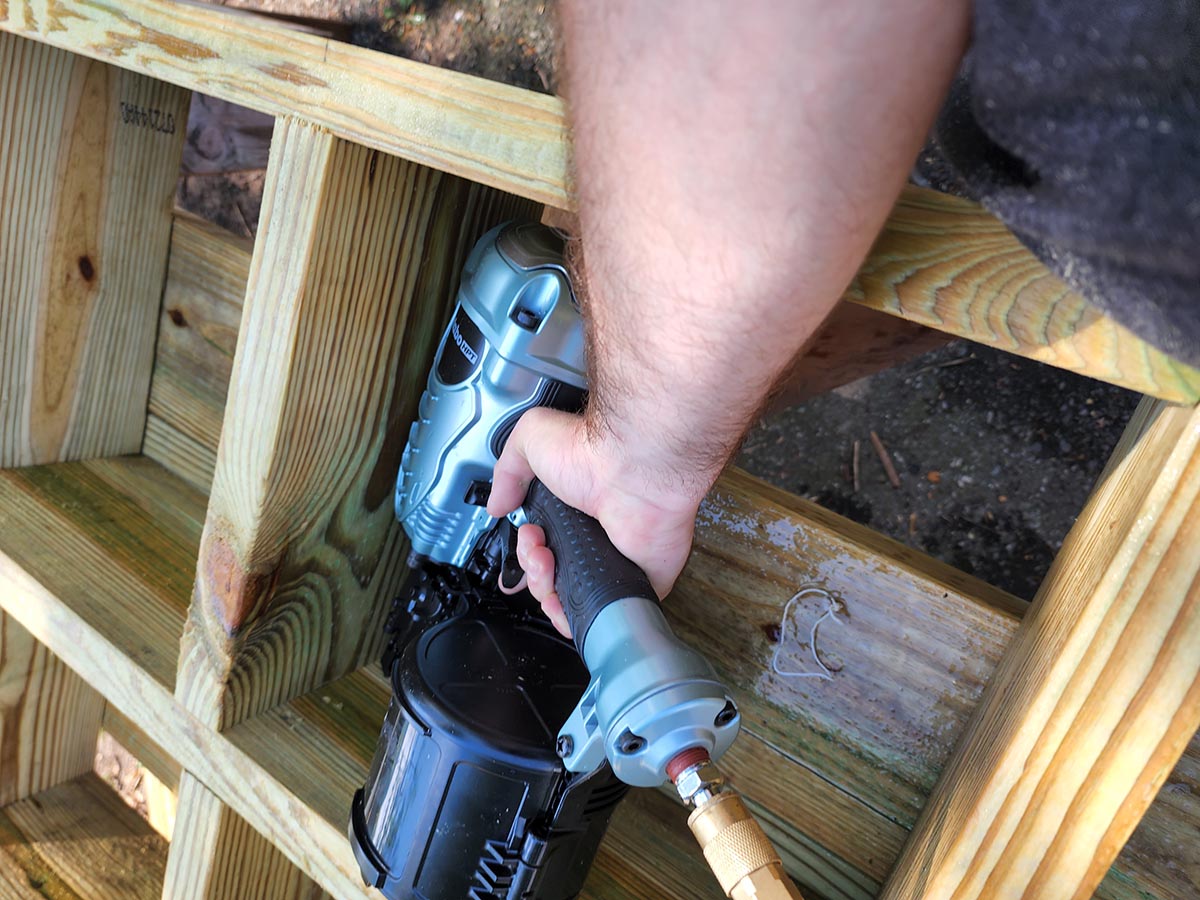
Types of Framing Nailers
There are different categories of framing nailers, and which tasks a particular model might suit depends on how it fires nails into wood. The three types of nailers are pneumatic, fuel, and cordless—each with its own pros and cons.
Pneumatic
Pneumatic framing nailers use compressed air supplied by an air compressor to create the force that drives the nail out of the gun and into the wood. On the plus side, they provide a consistent source of power, pack more force than their cordless and fuel-powered counterparts, and are lighter in weight than cordless nailers. They also allow for rapid firing, which can help facilitate a faster framing process.
However, these framing nailers are less convenient, as they require toting an air compressor to the jobsite. They’re also quite a bit louder to run on account of the air compressor.
Fuel
Although becoming less common with the arrival of cordless models, fuel-powered framing nailers are still fairly popular. They rely on a combination of a fuel cell and a rechargeable battery for power. A fuel-powered nailer is lighter in weight than a cordless model and will also last longer before the battery needs recharging or the fuel cell needs replacing. As far as the downside goes, replacement of the fuel cell adds to the expense of a fuel-powered nailer—and they’re not inexpensive. Plus, due to the combustion created by the fuel cell, this type of nailer will emit an unpleasant odor during use.
Cordless
Cordless framing nailers rely solely on their battery for power. This generally makes them heavier, as the battery adds weight to the gun. As with most cordless tools, their greatest asset is convenience. Since they needn’t be plugged into an outlet or an air compressor, they can be used on jobsites where electricity isn’t available.
It’s not all upside for cordless nailers, though. Often, these models prove more expensive than air or fuel-powered models since replacing the batteries after their tenure isn’t cheap.
What to Consider When Choosing the Best Framing Nailer
Now that you have a solid background on the types of framing nailers available, read on to bone up on their uses and the features to look for when shopping. Keep in mind the points that sound the most applicable to your specific needs.
Intended Use
As the name suggests, framing nailers are used for the construction task of framing a structure, such as a house, shed, garage, or other building. This requires nailers to drive large 10D nails, up to 3½ inches in length, into 2x4s, 2x6s, 2x8s, 2x10s, and more.
These lumber products are dense, so framing nailers must have a lot of power to drive such a large nail through them. For that reason, framing nailers are bigger, bulkier, and more durable than a finish nailer.
Power Source and Runtime
Framing nailers use either fuel, a battery, or an electric-powered air compressor to get the job done. These models aim to be competitive with each other, but their pros and cons do vary:
- Fuel-powered nailers, which also incorporate a rechargeable battery, can typically fire about 1,000 to 1,300 shots before needing a new fuel cell. These nailers and their fuel cells are expensive.
- A battery-powered nailer can typically fire up to 900 shots before the battery needs recharging. This is less than a typical fuel-powered model, but these models don’t emit odors.
- A pneumatic nailer uses an air compressor, and thus has a constant source of power, making it limited only by the number of nails in its magazine. However, the length of the compressor hose does anchor the framer somewhat.
Brushed vs. Brushless Motor
A battery-powered nailer, which uses an electric motor to fire nails, will either use a brushed or a brushless motor.
Brushed motors are the old-school design, with electric brushes conducting electricity to spin the motor. These brushes can require replacement, and they’re not the most efficient, but models using this tech are typically affordable.
A brushless motor is more efficient because it creates less friction and therefore loses less energy. Brushless motors are 85 to 90 percent efficient, while brushed motors are 75 to 80 percent efficient. This means a brushless nailer will have more firing power and last longer before the battery needs a recharge.
Framing Angle
The framing angle refers to the position of the nailer’s magazine—the long metal piece attached to the head of the tool that holds the nails. Most framing nailers have a magazine that is angled away from the head of the nailer to allow for easier maneuverability between studs or joists. The most common angles for framing nailers are 15, 21, 28, 30, and 34 degrees. These are fixed angles and are not adjustable, so it’s critical to buy nails that match the angle of the nailer. A 28-degree nail will not work in a 21-degree nailer.
The greater the angle, the more maneuverable the nailer is, which will allow the user to fit the head into tight corners. The best angle comes down to personal preference and the type of project. For framing projects that require the nailer to fit into tight spaces, such as between studs or in corners, it makes sense to have a 30- or 34-degree nailer, which provides the maximum amount of maneuverability.
Different types of angles also shoot different types of nails. Nailers with 15-degree or 21-degree angled magazines use full-round heads, which are more secure than clipped nails. A 28-degree framing nailer can use clipped or full-round head nails, while 30- and 34-degree nailers can only use clipped nails.
Stick-style vs. Coil-style Nail Storage
Framing nailers use two different styles of magazines: stick and coil.
- Stick magazine: A framing nailer that uses nails that come in long strips requires a stick magazine. Stick magazines have a lower capacity than coil magazines, but they create better weight distribution, making the tool easier to handle.
- Coil magazine: Framing nailers that use nails connected with long strings that coil around require a coil magazine. They have a larger nail capacity than stick-style magazines, and the shape allows for fitting the framing nailer into tighter spaces than with a stick magazine model.
It’s possible to make arguments for both types of nailers. For those who prefer a high-capacity magazine, such as production framers or those who primarily work in high above-ground places like roofs and rafters, coils are key. But for those who prefer something lightweight, stick-style magazines are better.
Nail Type
Framing nailers work with two types of nails: round head and clipped. Round-head nails, true to their name, have round heads, whereas a clipped nail has a head that appears to have a chunk taken out of it. This head shape allows the nails to sit flush against each other in a stack in the nailer’s magazine.
Carpenters consider round-head nails to be the more secure option, as a round head is less likely to pull through a piece of framing than a clipped nail. In fact, due to round-head nails’ holding power, some building codes strictly require round-head nails only. Since the round head prevents the nails from sitting flush next to each other, however, the trade-off is the magazine will hold fewer round-head nails than clipped ones.
Size and Weight
Size and weight are important factors when considering a framing nailer. A framer may have to crouch, stand on a ladder, or reach overhead throughout the day—all of which become more challenging with a heavy or cumbersome tool.
Because of their ability to drive 3½-inch nails into wood, framing nailers are considered one of the more dangerous power tools. A misfire can cause serious injury, sending a nail through a foot, a hand, or worse. To prevent accidents, it’s crucial that the nailer be comfortable to handle.
A framing nailer should be light enough for the user to manage comfortably and safely. Pneumatic nailers weigh around 7 or 8 pounds, fuel-powered framing nailers weigh between 8 and 9 pounds, and battery-powered nailers weigh between 10 and 11 pounds.
Additional Features
Framing nailers include various features for safety and material type. All framing nailers include a depth-adjustment knob, which allows control of how deep the nail penetrates the wood. Woods of different hardness and thickness will require different nail-depth settings. The best framing nailer will have depth adjustment that is easy to use, requiring only the simple turn of a knob.
Some framing nailers include protective guards, which shield the user from debris or nails that may deflect off material. Another possible feature may be integrated LED lights that indicate when nails or batteries are running low and provide lighting for the work area. Some pneumatic nailers allow users to adjust the direction of the exhaust to keep air from blowing in the face.
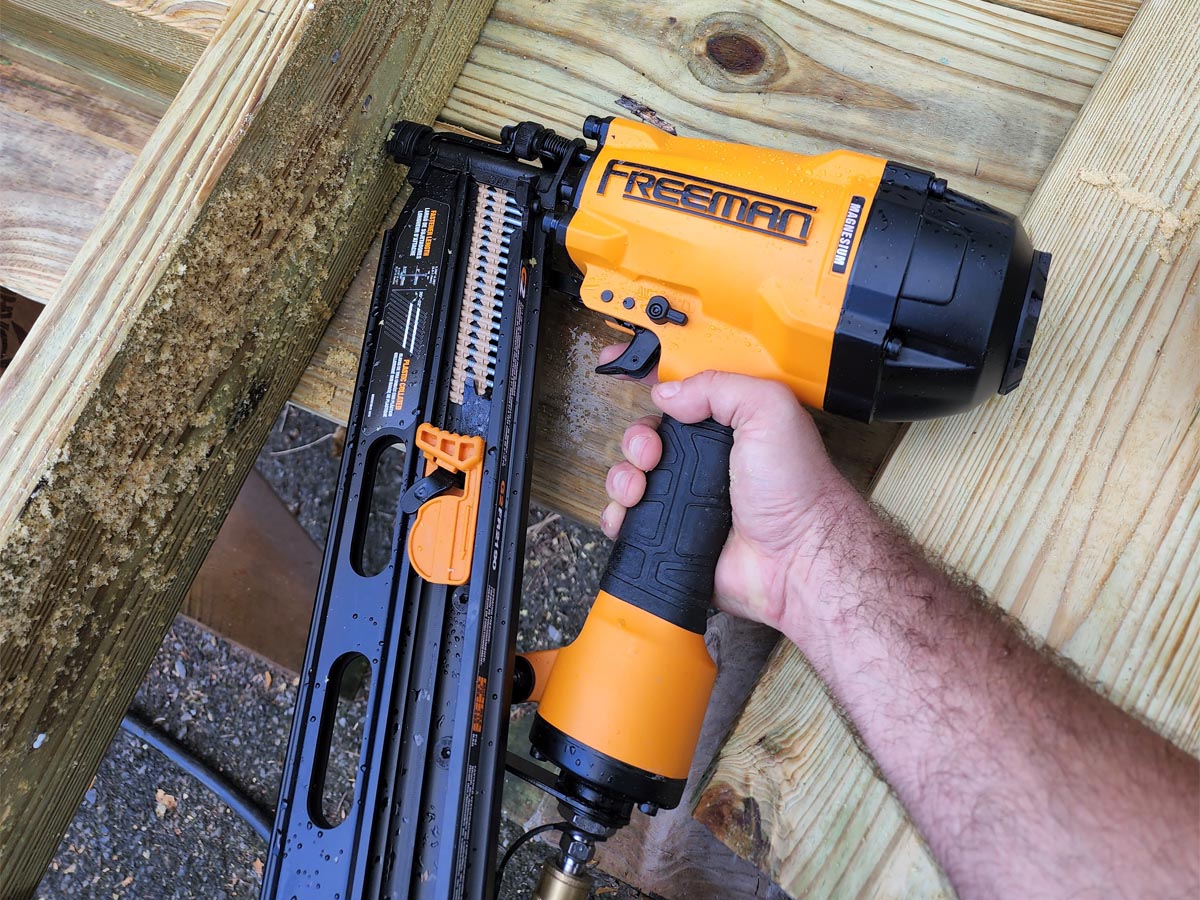
Our Top Picks
Even with all of that background information on framing nailers, shopping for one of these tools can be intimidating. To help streamline the process, check out the following list of top models. The lineup includes some of the top battery, fuel, and pneumatic framing nailers on the market from some of the most highly regarded tool manufacturers in the business.
Best Overall
Metabo HPT NR90AES1 21-Degree Framing Nailer
See ItThis lightweight, high-performance framing nailer boasts a number of additional features that make it one of the best in class. A pneumatic nailer that drives nails up to 3½ inches long, it has a rubber grip and weighs just 7½ pounds. The magazine features a 21-degree angle to offer a bit of maneuverability, allowing buyers to fit in some tighter spots while still utilizing round-head framing nails.
It also features an easy-to-disassemble head, so users can quickly clear jams that might occur. Another convenient feature is its toolless depth adjuster, which allows users to make adjustments without changing the pressure on the air compressor. There’s also a switch that allows for toggling between bump and sequential fire on the fly, and the soft rubber grip offers improved comfort. If there is a complaint, it’s that there isn’t an adjustable exhaust, so framers will need to keep their faces clear of the air discharge.
During testing, we found the NR90AES1 to be everything it’s cracked up to be. It held lots of nails, the magazine was smooth and easy to fill, and switching between modes was a breeze. The grip was also comfortable, and the depth adjustment was easy to use. This was, however, the sole nailer tested that we found challenging to attach the air hose to, as the angle of the magazine made it necessary to swap hands to get to the quick-connect fitting. But once the user becomes familiar with the long magazine (it can be tricky to maneuver), this is one excellent framing nailer.
Product Specs
- Power source: Pneumatic
- Style: Stick
- Angle: 21 degrees
Pros
- 21-degree magazine for improved maneuverability
- Lightweight at just 7½ pounds
- Toolless depth adjustments
Cons
- No adjustable exhaust
Get the Metabo HPT framing nailer at Amazon, Acme Tools, or Toolbarn.
Runner-Up
Freeman G2FR2190 Pneumatic 21-Degree Framing Nailer
See ItA quality build and extra features make this pneumatic Freeman nailer worth consideration. The nailer has a lightweight yet durable magnesium-and-aluminum body, which gives it a weight of just under 8 pounds. Its 21-degree angled magazine allows for maneuverability while still making it compatible with full round-head nails. It will fire nails up to 3½ inches long, and an integrated switch allows for quickly switching between single fire and bump fire.
Helpful features include an adjustable exhaust to keep air out of the user’s face during use, no matter what position they’re in. A depth adjuster allows users to fine-tune nail depth for different materials and wood sizes. Plus, they can switch between a no-mar tip for protecting the wood and a no-slip tip that grips the wood for accurate firing.
While Freeman might not be one of the more popular names in framing nailers, we thought it might be worth a shot so we tested it out. Other than the fact that a bunch of the parts are plastic, it passed with flying colors. The sequential firing was easy to switch into—a big improvement over the old model’s interchangeable trigger. We also liked the adjustable exhaust port that kept the air off our faces even while working in tighter spaces and prevented sawdust from flying back our way when nailing on the deck.
Product Specs
- Power source: Pneumatic
- Style: Stick
- Angle: 21 degrees
Pros
- Adjustable exhaust port
- Sequential firing switch a big improvement
- No-mar tip removes easily for nonslip tip
- Adjustable exhaust redirects airflow away from the face
Cons
- Not a popular or well-known framing nailer brand
- Plastic magazine parts
Get the Freeman framing nailer at The Home Depot or on Amazon.
Best Bang for the Buck
NuMax SFR2190 Pneumatic 21-Degree Framing Nailer
See ItThis pneumatic framing nailer performs as well as some of the higher-priced competition. With its 21-degree angle magazine, it can handle full round-head nails and still fit into smaller spaces than a 15-degree nailer. A die-cast magnesium body affords durability while keeping things light at 8½ pounds. A dual-mode trigger allows for single-select or sequential firing, helping to speed up big framing jobs that require a lot of nails (though it does require swapping the trigger).
This nailer, which can handle nails up to 3½ inches long, also includes a depth adjuster to fine-tune for different sizes of dimensional lumber and hardwoods. An adjustable exhaust, which redirects air away from the user’s face, can also be used to blow debris away from the work space. Also, an anti-dry-fire mechanism prevents the user from firing when the magazine is empty, which could damage the tool. Its 55-nail capacity makes this a good option for small to medium-size jobs.
This just might be the best deal in framing nailers. We enjoyed using it as much as the others in the lineup, and it didn’t jam or act up during testing. The magnesium body felt relatively light, and the magazine was smooth and straightforward to operate. We personally were not big fans of the no-mar tip, but the teeth worked quite well, even for angled shots. And while we did find the trigger swap to be a bit of a pain, we could grin and bear it for this budget-friendly price.
Product Specs
- Power source: Pneumatic
- Style: Stick
- Angle: 21 degrees
Pros
- Affordable price point
- Adjustable exhaust port for redirecting airflow
- Toolless depth adjustment
- No-mar tip and nonslip tip
Cons
- Requires swapping triggers for bump activation
- No-mar tip was slippery
Get the NuMax framing nailer on Amazon.
Upgrade Pick
Metabo HPT NR83A5 21-Degree 3-1/4 Inch Framing Nailer
See ItThere are no two ways about it: Pros need a powerful framing nailer like this Pneumatic Framing Nailer from Metabo HPT. This 21-degree pneumatic nailer features a cylinder-valve drive system that offers improved durability and faster nailing. Also, the long high-capacity magazine is designed to withstand the rigors of a jobsite as well as doubling the number of nails standard pneumatic nailers can hold. However, the maximum nail length it can hold is 3¼ inches, which is shorter than most comparable models.
This model includes an open-nose design that makes it easy to extract jammed nails that might otherwise slow the job down. Despite its sturdy all-metal build, this nailer weighs less than 9 pounds, and its ergonomic grip allows for a firm, comfortable hold. Other features include a toolless nail depth adjuster, a handy built-in rafter hook, and an adjuster on the trigger for either sequential or contact nailing.
This nailer proved to be a clear favorite during testing. The extended magazine held more nails than the others, and the operation was smooth as silk. It is a little long for tight spaces, and the average DIYer might struggle to find a place to store it (tip: save the box!), but none of the other models could touch its quality and capacity. We especially liked how this model contained almost no plastic, and how the depth-adjustment knob was front and center.
Product Specs
- Power source: Pneumatic
- Style: Stick
- Angle: 21 degrees
Pros
- Receives 2 strips of nails
- Open-nose design for clearing jams
- Built-in rafter hook
Cons
- Slightly shorter nail length (3¼ vs. 3½ inches)
Get the Metabo HPT pneumatic framing nailer on Amazon or at Acme Tools.
Best Cordless
Metabo HPT NR1890DRS Cordless Framing Nailer Kit
See ItFraming nailers need ample power to do their job, and some battery models can fall short in that area. That’s not the case with this robust Metabo HPT thanks to a brushless motor and a 3 amp-hour (Ah) battery that make it powerful enough to drive 2-inch to 3½-inch nails flush into framing at a rate of two nails per second.
With the ability to drive 400 nails per charge, this is one long-lasting cordless framing nailer. If need be, though, an 8Ah battery capable of shooting up to 1,100 nails on a single charge is available. In terms of additional features, this Metabo framing nailer features a switch that transitions between sequential and bump mode and a nail-depth adjuster.
At just over 10 pounds, it was a little heavy during our test, but that didn’t offset how great this thing was to use. It kept up with bump nailing, no problem—despite coming with just a 3Ah battery—and it was compact and easy to maneuver. It was especially nice to work without a loud compressor in the background as well. Two complaints, however: The on/off and mode buttons are in a somewhat awkward spot, and it was the only model to jam during testing—and on a very shallow angled shot.
Product Specs
- Power source: Cordless 18-volt battery
- Style: Stick
- Angle: 21 degrees
Pros
- Ultimate portability thanks to a cordless design
- Toolless depth adjustment
- Drives 2 nails per second
Cons
- On/off switch is in a weird spot
- Jammed once during testing
Get the Metabo HPT cordless framing nailer kit on Amazon or Toolbarn.
Best Coil-Framing Nailer
Metabo HPT NV90AGS Coil-Framing Nailer
See ItFor big jobs like framing an entire house, DIYers may not appreciate stopping frequently to refill a standard straight magazine. This coil-framing nailer from Metabo HPT holds up to 300 nails, and when it is time to refill, a convenient side-load magazine allows for quick fastener replacements.
Just as powerful as the brand’s straight-stick-style model, this coil framing nailer can drive nails up to 3½ inches long. Despite its increased payload, at less than 8 pounds, it’s also lightweight. Additional features include a toolless depth adjuster and an open-nose design for easy removal of jams. Do keep in mind that this nailer, like all of Metabo’s current offerings, is rebranded Hitachi gear. Some of the branding is confusing, but they’re still the same reliable models the industry is used to.
Nothing else in the test fit in tight spaces as well as the Metabo HPT Coil Framing Nailer. Our framing project had joists that were closer to 15.5 on center, and this nailer was able to get in there. Loading and reloading was a breeze (something not all coil framers excel at), and it truly did feel lightweight. If we had to complain, we’d say that the plastic magazine parts seem a little flimsy, but that’s the trade-off for a lightweight nailer.
Product Specs
- Power source: Pneumatic
- Style: Coil
- Angle: N/A
Pros
- Lightweight design, yet holds up to 300 nails
- Toolless depth adjustment
- Open nose for clearing jams
Cons
- Lots of plastic on the magazine
Get the Metabo HPT coil-framing nailer on Amazon or at Acme Tools.
Also Consider
Estwing EFR2190 21-Degree Full Head Framing Nailer
See ItWhile it’s not the cheapest framing nailer on the list, the Estwing EFR2190 framing nailer is a bargain. This model features a 21-degree angle for general-purpose use, and the magnesium body helps to keep the weight down for all-day work. It accepts nails up to 3½ inches, and it includes a padded carrying case, a rafter hook, and Allen wrenches.
This framing nailer comes with a built-in switch that allows the user to go back and forth between single fire and bump firing without replacing the trigger. The toolless depth adjustment is a big boost to productivity, as switching between framing lumber and plywood will take mere seconds. Plus, to protect the gun, it features an anti-dry-fire mechanism to prevent it from firing when the magazine is empty. There’s also an adjustable exhaust port to protect the user’s face.
In testing, the performance of this Estwing model proved to be on par with our Runner-Up pick, but it’s a bit less expensive and boasts a couple of extras we really liked. Instead of a standard male hose connection, it features a swivel connection that actually made a huge difference in maneuverability. It also comes with a nice padded carrying case to keep it safe. The only bummer? All those plastic magazine parts.
Product Specs
- Power source: Pneumatic
- Style: Stick
- Angle: 21 degrees
Pros
- Padded carrying case included
- No-mar tips remove easily for nonslip tip
- Swivel-hose connection for better range and angles
Cons
- Lots of plastic magazine parts
Get the Estwing framing nailer on Amazon or at The Home Depot.
Our Verdict
For those looking for a top-notch pneumatic framing nailer, check out the Metabo HPT framing nailer for its lightweight design and toolless adjustments. For those who prefer to cut the cord (or hose), the Metabo HPT cordless framing nailer kit’s battery-operated design might be just the ticket.
How We Tested the Best Framing Nailers
There’s a lot riding on a list of the best framing nailers, so our extensive experience working with these tools informed us of which features were must-haves. Next, we collected tools from all of the top brands in the framing nailer field for review. After extensive product research, we narrowed our group of framing nailers down.
We used each of the nailers for different aspects of a few different jobs. We used each on a small framing job as well as building a portable pitching mound. Some of the wood was very dry and easy to work with, while the rest was extremely wet, heavy, and resistant to nailing.
We nailed through the top and bottom plate, as well as between studs for blocking, and toenailed boards in as well. We then switched each model to sequential firing and drove nails into a 4×4 post repeatedly, attempting to cause a jam or misfire, or test the dry-fire lockout.
Based on those tests, we compared how each nailer performed to assess capability, features, and quality, then gave awards to each model based on their strengths.
Safety Tips for Using a Framing Nailer
An accident with or misuse of a framing nailer could cause major or even fatal injury. The following safety practices are crucial to avoid harming anyone:
- Treat a framing nailer as a firearm and never point it at anyone, even when it’s disconnected from its power source.
- When clearing a jammed nail, always disconnect the power source from the framing nailer first.
- A framing nailer’s power can cause both debris or nails themselves to fly out unpredictably in all directions, so always wear safety goggles during use. To prevent potential hearing loss, it’s also a good idea to wear ear protection during prolonged use.
- Be aware of others around the site, and avoid using the nailer if someone is in close proximity, as there’s always the potential for a nailer to misfire or fire through the material.
- When carrying the nail gun, always keep the tip facing away from your body and make certain your fingers are not placed over the trigger to avoid accidental firing.
FAQs
If you still have questions about which framing nailer is right for you, read on to learn more about size, angle types, and other concerns.
Q. What size framing nailer do I need?
Size is rarely an issue when it comes to framing nailers. Almost all framing nailers will fire the 3½-inch 10D nails required for framing. Instead, consider angle, weight, and type, all of which are discussed in detail above.
Q. Can I use 21-degree nails in a 30-degree nailer?
You cannot use 21-degree nails in a 30-degree nailer. The clips of nails for a 30-degree nailer versus a 21-degree nailer are very different, so they cannot work interchangeably between the two types of framing nailers.
Q. Can I use screws instead of nails for framing?
Nails are typically used for framing as they have more tensile strength than screws. Whereas nails will bend under pressure, screws are more brittle and therefore more likely to snap. That said, there are newer high-tensile screws on the market designed specifically for framing. You cannot, however, use screws in a framing nailer. If you plan on framing with screws, you’ll need to use an impact driver or a cordless drill.
Q. Can I use a siding nailer for framing?
While you can use a framing nailer for siding (by fitting it with short 2-inch screws), you cannot use a siding nailer for framing. Framing nailers require 3½-inch nails that can penetrate deep enough to create a secure connection between 2×4 boards. Siding nailers can only handle nails up to 2½ inches, so they won’t work for framing.
